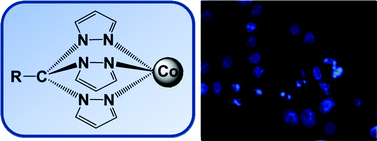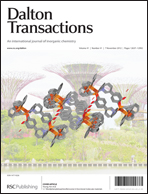Cobalt complexes bearing scorpionate ligands: synthesis, characterization, cytotoxicity and DNA cleavage†‡
Abstract
A number of novel, water-stable redox-active cobalt complexes of the C-functionalized tripodal ligands tris(pyrazolyl)methane XC(pz)3 (X = HOCH2, CH2OCH2Py or CH2OSO2Me) are reported along with their effects on DNA. The compounds were isolated as air-stable solids and fully characterized by IR and FIR spectroscopies, ESI-MS(+/−), cyclic voltammetry, controlled potential electrolysis, elemental analysis and, in a number of cases, also by single-crystal X-ray diffraction. They showed moderate cytotoxicity in vitro towards HCT116 colorectal carcinoma and HepG2 hepatocellular carcinoma human cancer cell lines. This viability loss is correlated with an increase of tumour cell lines apoptosis. Reactivity studies with biomolecules, such as reducing agents, H2O2, plasmid DNA and UV-visible titrations were also performed to provide tentative insights into the mode of action of the complexes. Incubation of Co(II) complexes with pDNA induced double strand breaks, without requiring the presence of any activator. This pDNA cleavage appears to be mediated by O-centred radical species.


 Please wait while we load your content...
Please wait while we load your content...